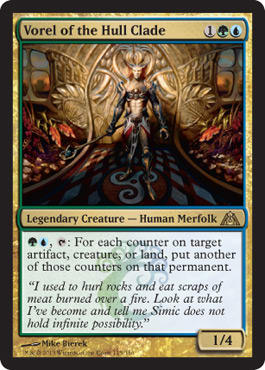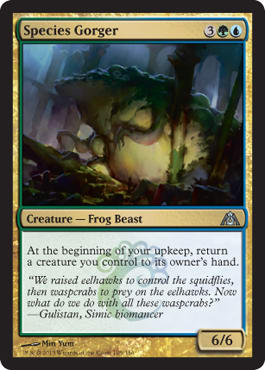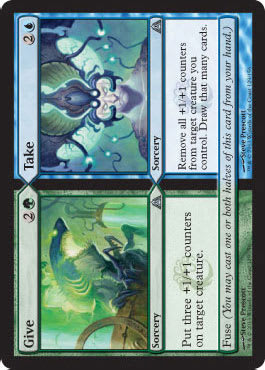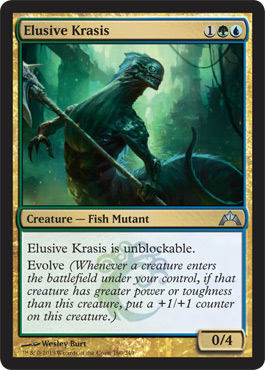Welcome to the next round of Meddlings! We had a great run for Return to Ravnica and Gatecrash, and now, five of the guilds are back with new decks for Dragon's Maze. This time around, we'll be doing something a little bit different. With Dragon's Maze as a small set, there wasn't a lot of room to add to the card pool for each of the guilds. That means while we see all-new decks, the card pool didn't grow profoundly deeper. I was a little concerned that the Meddlings for these next five decks would bear too much a resemblance to the ones we've already done, giving it a feeling akin to last night's leftovers heated up with a new side of vegetables. That's when a reader comment over at Ertai's Lament gave me an idea.
Although it's been awhile since I've done them, there's an occasional series I've written called "Ertai's Trickery," in which I take similarly-themed preconstructed decks, blend them together for a card pool, and distill the best sixty-card construction for them. Those interested in these early works are certainly invited to check out The Bloodsucker's Ball (fusing together Rise of the Vampires from Zendikar, Worldwake's Fangs of the Bloodchief, and Magic 2011's Reign of Vampirism) or The Mad Machinist's Mash-up (Tezzeret's Duel Deck, Planechase's Metallic Dreams, and Assemble the Doomsday Machine from Archenemy). Today, however, we are boldly forging into new territory: five of the guilds of Ravnica!
The aim of the Meddling series has been to illustrate fundamental principles of deck-building by using an Intro Pack as a starting point, adhering to a couple of rules to keep the deck accessible and affordable. We'll be doing much the same here, but our challenge will be to make the best deck we can for each guild from the two they've been given. That means one deck from Dragon's Maze and the earlier deck from either Gatecrash or Return to Ravnica. The contents of those two decks will form our card pool, and we'll build from there. It's a different exercise, but it’s one that can similarly highlight the decision-making that comes with assembling the right deck.
What better way to kick off this innovative twist on the Meddling format than with the guild for whom evolution and innovation is—quite literally—in their DNA?
About the Simic
We know from playing the guild that there are a few things we must take into consideration when structuring a deck that will take greatest advantage of their unique talents and characteristics.- The Simic's evolve mechanic is powerful, particularly on cheaper creatures that have the greatest chance to evolve multiple times throughout the game.
- However, these creatures tend to be on the small side, with price tags that can be a little inflated for what you get at the outset.
- That leaves the deck vulnerable early on, particularly to a creature rush.
- Therefore, the Simic deck works best when it's reliably able to field high-toughness defenders, which not only buy it the time it needs to grow its army, but also move its creatures one more rung up the evolutionary ladder.
With that in mind, we'll have a general game plan in mind as we assess the card pool we get from Simic Domination and Simic Synthesis. Breaking open both decks and combining their cards give us the following raw materials:
"Simic Domination + Simic Synthesis"
- Creatures (43)
- 1 Archweaver
- 1 Chronomaton
- 1 Fathom Mage
- 1 Frilled Oculus
- 1 Gyre Sage
- 1 Ivy Lane Denizen
- 1 Leyline Phantom
- 1 Merfolk of the Depths
- 1 Murmuring Phantasm
- 1 Zameck Guildmage
- 2 Adaptive Snapjaw
- 2 Battering Krasis
- 2 Beetleform Mage
- 2 Crowned Ceratok
- 2 Drakewing Krasis
- 2 Kraken Hatchling
- 2 Opal Lake Gatekeepers
- 2 Sapphire Drake
- 2 Shambleshark
- 2 Species Gorger
- 3 Centaur Courser
- 3 Cloudfin Raptor
- 3 Crocanura
- 3 Elusive Krasis
- 1 Vorel of the Hull Clade
- Spells (25)
- 1 Tower Defense
- 2 Bioshift
- 2 Hindervines
- 2 Mutant's Prey
- 1 Give // Take
- 1 Phytoburst
- 1 Sleep
- 1 Unexpected Results
- 1 Urban Evolution
- 1 Krasis Incubation
- 2 Bred for the Hunt
- 2 Encrust
- 2 Forced Adaptation
- 2 Runner's Bane
- 2 Simic Cluestone
- 2 Simic Keyrune
- Lands (52)
- 22 Forest
- 25 Island
- 5 Simic Guildgate
Let's begin with the creatures, which form the basis for most Intro Pack decks and are the very linchpins of the Simic. We'll break them out into groups by converted mana cost, letting us make some early cuts before boiling down to the final roster.
The Early Game (1- to 2-drops)
For the Simic, the early game is all about planting seeds to sprout later in the match—and impeding an opponent from making it too far ahead in the race. Because Simic creatures tend to be a bit small for the mana cost, you'll often find yourself losing the race to a more efficient opponent, so being able to buy time is crucial. You can't always count on evolving your way up the chain right out of the gate, though when you do, you'll be the one leaving your opponent in the dust.
Two of the deck's most important creatures are available to us as early as our first turn. The Cloudfin Raptor is among the guild's all-star cards, thanks to its evasion and ease of growth. Of course, “ease of growth” is a double-edged sword, as this little 0/1 that could offers no initial threat whatsoever.
We'll also want to keep our pair of Kraken Hatchlings. Though Dragon's Maze has given us a slightly larger version in the Murmuring Phantasm, Simic Domination only offers a miser's copy, and we'll want more robust defenses. As stated above, their purpose is twofold, and they are superb evolve enablers that also buy us the time the deck wants to grow.
Our first rare card also appears here in the form of the Gyre Sage. Return to Ravnica block Intro Packs have increasingly gorged on mana, with an unfortunately high land content in addition to their Keyrunes and Cluestones. We'll be cutting some of that fat out to make room for other cards, and unfortunately, the Sage will be receiving her pink slip. It's not that she isn't a strong card, for generating multiple mana from one activation is a tantalizing prospect. Instead, it's that as a rare, we only have access to one copy, and that's simply too inconsistent. If a turn-two Sage is living the dream, a turn-six Sage is a relative nightmare. She won't evolve most of your other creatures by then, she has little prospect of much growth herself, and the mana isn't likely to be as crucial.
Another highlight here is the Zameck Guildmage. Thanks to a useful mix of abilities, the Guildmage gives you a great place to spend that mana later in the game, when cards in hand grow dearer. We also find our second evolve body in the flash-bang Shambleshark, another mana sink in the Frilled Oculus, and an easy cut in the far-too-slow Chronomaton.
The Midgame (3- to 4-drops)
The 3-drop slot for the Simic is something of a danger zone—it's here where your opponent can really start to pass you in the arms race. That Battering Krasis holds a lot of potential, but it’s woefully outclassed on its own by your opponent's simple Centaur Courser (which, conveniently, also appears here). The Coursers are actually a strong option for the Simic, as their efficient bodies offer some muscular insurance against a slow start while also evolving any earlier plays.
The Beetleform Mage occupies a similar role as the Guildmage, being another solid mana sink for later. Our evolve options here are the trampling Battering Krasis, the air-defense Crocanura, and the stealthy Elusive Krasis, which also supports our early defensive ambitions. The Drakewing Krasis gives us a solid body in the air, albeit a fixed and fragile one. Vorel of the Hull Clade is an auto-include, doubling the number of counters our creatures have each turn.
While the 3-drops give us the chance to build our army, the 4-drops are a bit underwhelming for our needs. The prospect of an extra card off the Opal Lake Gatekeepers and a 2/4 body isn't bad, but ideally, if we're paying 4 mana for something, we'd like it to bring a little more impact to the table. The same goes with the Fathom Mage (see the Gyre Sage above) and the Ivy Lane Denizen. Crowned Ceratoks, on the other hand, are just what the doctor ordered. We have to avoid packing our deck with Walls and small evolve creeps since that puts all of our eggs in the evolve basket. As with the Centaur Coursers, some green beef helps prop the deck up when things don't go according to plan.
The Later Game (5-drops and higher)
Unlike some of the faster guilds, this is where the Simic will really be hitting its stride. By now, you've typically managed to congest the red zone with your defensive options and grown a few threats through evolve. It's time to flip the switch and close out the game. Which of these luxury-priced options will best help you do that?
Probably not the Adaptive Snapjaw, and certainly not the Archweaver. Neither brings enough on its own to justify its cost in a field crowded with competition. Despite the flash, the Merfolk of the Depths falls into the same class, and the Leyline Phantom's spot on the bench was earned thanks to its cleverish synergy with the deck. By returning to hand for recasting, it lets you slowly grind up some more +1/+1 counters.
Dragon's Maze gives us something better, though, in the Species Gorger. The only time you're really unhappy to play a 5-mana 6/6 is when that's the only creature you have on the board, in which case you're probably circling the drain anyway. Not only will it evolve everything on the board when it arrives, but it also puts those Kraken Hatchlings and that Murmuring Phantasm to noble purpose by turning them into cheap, repeatable evolve triggers.
While we're here, we'll also grab a Sapphire Drake. Too expensive to want two, these can end the game in a stroke if your opponent is vulnerable in the skies.
The Supporting Suite
This part of the construction is fairly straightforward. Intro Packs frequently pack a tepid removal suite, so we should be able to cobble together a serviceable one from the contents of both decks. The Simic rely heavily on the red zone to win, so anything that helps us keep it clear of obstruction is especially welcome.
Right off the bat, that means we'll be taking our Encrusts, Krasis Incubation, Mutant's Preys, Runner's Banes, and Sleep. That's eight cards sorted, leaving us room for four more. Although some cards offer some added functionality with +1/+1 counters, these often aren't worth the slot. Bioshift, for example, doesn't actually add anything to the battlefield, instead just redistributing what's already there. Forced Adaptation, meanwhile, is glacially slow—and an Aura to boot. Give // Take, however, adds new counters to a creature, with the option of cashing in for more cards. That's a keeper.
Unexpected Results won't be considered—it's best-used in a deck in which you can realize significant mana savings by playing it—and this isn't such a deck. Similarly, Hindervines and Bred for the Hunt require more evolve creatures to be of maximum value, while our finished deck will only have about one-third of its troops with that ability.
In fact, there's not a lot left here to become excited about, so we can go back and add a couple of extra creatures to make up the difference. Let's see how the final deck shakes out.
"The Simic Combined"
- Creatures (27)
- 1 Murmuring Phantasm
- 1 Sapphire Drake
- 1 Zameck Guildmage
- 2 Beetleform Mage
- 2 Crowned Ceratok
- 2 Drakewing Krasis
- 2 Elusive Krasis
- 2 Kraken Hatchling
- 2 Shambleshark
- 2 Species Gorger
- 3 Centaur Courser
- 3 Cloudfin Raptor
- 3 Crocanura
- 1 Vorel of the Hull Clade
- Spells (9)
- 2 Mutant's Prey
- 1 Give // Take
- 1 Sleep
- 1 Krasis Incubation
- 2 Encrust
- 2 Runner's Bane
- Lands (24)
- 11 Island
- 9 Forest
- 4 Simic Guildgate
The Matchups
To gauge the improvements to the deck, I challenged Sam to a rematch from the original review we had of the deck on Ertai's Lament. Having trounced me in that playtest, Sam and her Rakdos were eager for more—but this time around, they wouldn't find such easy pickings.
Although a couple matches did see the Rakdos prevail—usually off a Morgue Burst after bringing my life total down either in the red zone or with Havoc Festival, the Simic were very consistent. I typically could expect some quick defense from either the Kraken Hatchling, Murmuring Phantasm, or Elusive Krasis, and evolution felt as though it fit normally within a curve of creatures rather than being forced. Indeed, evolve triggered so reliably that it no longer felt conditional, but rather a way of just cheating out bigger creatures for less.
As expected, Species Gorger along with the Hatchling or Phantasm was a useful combo, while Mutant's Prey was superb with an Elusive Krasis thanks to the latter's high survivability. It's not an ideal answer (unless a Give is involved, typically), but it could make short work of the Rakdos's bevy of high-power, low-toughness threats.
All in all, it was an enjoyable build to pilot. What about you? Given the same initial pool of cards, what might you have come up with?
Jay Kirkman
































